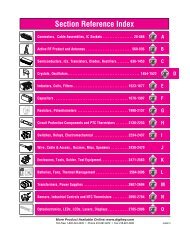Microcontroller Solutions TechZone Magazine, April 2011 - Digikey
Microcontroller Solutions TechZone Magazine, April 2011 - Digikey
Microcontroller Solutions TechZone Magazine, April 2011 - Digikey
Create successful ePaper yourself
Turn your PDF publications into a flip-book with our unique Google optimized e-Paper software.
The transport layer adds the most critical feature to the<br />
communication stack. TCP (transmission control protocol) is one of<br />
the transport layers in TCP/IP. This layer is responsible for creating a<br />
virtual connection between two logical points (not nodes). The logical<br />
points are referred to as sockets. The socket’s API is actually defined<br />
by the session layer.<br />
Last, at the highest level, is the application layer. This application<br />
defines the common protocols used on the Internet: HTTP, SMTP, and<br />
TFTP. This layer can also be used for custom protocols.<br />
Movement up and down the stack is an area of inherent inefficiency<br />
in a communication stack. To improve efficiency, higher-performance<br />
stacks use pointers instead of copying the data multiple times (this is<br />
sometimes referred to as zero copy). Pointer arithmetic is significantly<br />
more efficient with a 32-bit core using true 32-bit registers. This is a<br />
big advantage for the ColdFire 32-bit architecture.<br />
In addition, extracting data from individual fields in a header can<br />
become a single-instruction operation by using advanced addressing<br />
modes with offset capability.<br />
Figure 3: Seven-layer OSI model.<br />
ColdFire family of microcontrollers<br />
The ColdFire family of microcontrollers is based on the 32-bit ColdFire<br />
cores. The ColdFire core is available in four varieties, each a superset<br />
of the core below it. The cores are completely scalable, with the<br />
differences consisting of additional instructions or add-on modules<br />
(for instance, MMU) and longer pipelines to increase frequency<br />
and performance for demanding applications. The current V1 core<br />
contains the base register and instruction set. The V2 core adds<br />
additional instructions and addressing modes to the V1 core, along<br />
with an optional eMAC (Enhanced Multiply/Accumulate unit).<br />
Figure 4: ColdFire cores: scalable instruction sets, features and performance.<br />
Advantage of a 32-bit architecture<br />
The true 32-bit architecture of ColdFire microcontrollers lends<br />
itself well to efficient communication stack data movement. In a<br />
communication stack such as TCP/IP, the packet comes in at the<br />
bottom of the stack and propagates up. Data to be sent starts at the<br />
top of the stack as a buffer, and then works its way to the bottom of<br />
the stack to be sent out as a packet.<br />
Figure 5: Seven-layer OSI model with communication stack overlaid on top.<br />
ColdFire Fast Ethernet Controller (FEC)<br />
The FEC module is the ColdFire interface to the Ethernet world. The<br />
FEC module is consistent from the highest-performance V4-corebased<br />
part all the way down to the V1 core. This consistency means<br />
that drivers written for one Ethernet-enabled ColdFire processor will<br />
work on any Ethernet-enabled ColdFire processor (memory allocation<br />
would be the biggest difference).<br />
The FEC module is a high-performance Ethernet engine with a very<br />
rich heritage. The FEC module started out in the MPC860T. This highperformance,<br />
Power Architecture-based processor quickly became<br />
a powerhouse in the Ethernet world, going into high-performance<br />
routers and telecommunication equipment. The MPC860T was so<br />
popular in the Ethernet world that if you make a call today, chances<br />
are that somewhere along the way the voice data of your call will<br />
pass through an MPC860T.<br />
The MPC860T came out in the mid-1990s. The FEC module has been<br />
tested and improved upon for over ten years in some of the highest<br />
performance Ethernet environments. The FEC module from the<br />
MPC860T is now in the ColdFire line of processors.<br />
ColdFire FEC features<br />
• Ethernet MAC is designed to support 10 Mbps and 100 Mbps<br />
Ethernet/IEEE 802.3 networks<br />
• IEEE 802.3 full-duplex flow control<br />
• Support for full-duplex operation (200 Mbps throughput)<br />
www.digikey.ca/microcontroller<br />
27














